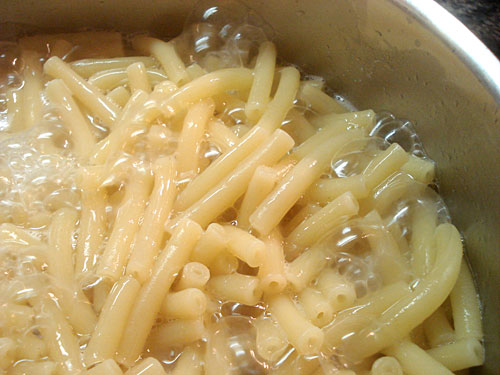Quick tip: Cooking pasta and noodles in just a little water

A few weeks ago, there was an article in the Food section of the New York Times about cooking pasta in a reduced amount of water (registration required), written by Harold McGee aka The Curious Cook. (In case you don't know, Harold McGee is a very interesting food writer, who approaches cooking from a scientific angle. If you are of a geeky bent or love reading about the hows and whys of food in general, I highly recommend his book On Food and Cooking.) The gist of the article is that it's possible to cook pasta in far less water than is usually recommended, and that you can even start from cold water!
While the rationale in the article for reducing the amount of cooking water is to save energy, I was intrigued by the possible time saving benefits, especially when making bentos. Up until now I've tried to save as much time as possible by boiling water in an electric kettle (which is high on my list of essential bento making equipment), then pouring it into a pot to cook pasta. But I was still using plenty of water in relation to the amount of pasta (around 6 cups for a cup of dry pasta). I'd often re-boil another potful of water for cooking other things, like vegetables.
In the New York Times article, Mr. McGee uses about 1 to 1.5 quarts (about 1 to 1.5 litres) of cold or boiling water and 2 teaspoons of salt for a pound (450g) of dry pasta. Since I usually only cook about 1 to 1.5 cups of dry pasta (around 100g to 150g) for bentos, that's the amount I started with. I put 1 cup of macaroni into a fairly small saucepan, added about 2 cups of cold water (just enough to cover completely) plus about a teaspoon of salt, and started cooking at high heat.
I needed to stir it around a bit to keep the pasta from sticking to itself and the bottom of the pan, but the water came to the boil in about 3 minutes. I then lowered the heat a bit to a fast-bubbling simmer and let it cook, stirring occasionally, and it took the normal amount of cooking time, about 9 minutes (your time may vary according to the pasta).
In the meantime, I chopped up and sautéed some vegetables and chicken in a frying pan on another burner. Once the pasta was drained, I tossed it into the frying pan for a few minutes. Including the cooling time of about 5 minutes and the time it took me to pack it into a box and so on, I had a all-in-one pasta dish ready to go in under 20 minutes. Not bad! A few hours later (i.e. lunchtime) the flavor of the pasta was not noticeably different from pasta cooked in the regular way for me, and I didn't notice any gumminess or excess starchiness. It certainly had a much better texture than pasta made the night before and re-heated in the morning - which, as you all probably know already, is the other time-saving method for pasta bentos.
I did another pasta boiling experiment, but this time to try to get the water to come to a boil even faster, I put a lid on the pan. Umm, big mistake. The water combined with the starch of the pasta to boil up and out of the pan, flooding the rangetop. I'm sure there is a scientific explanation for why this happens if you put a lid on the pan, but my copy of On Food and Cooking is still in storage so I can't look it up now.
Moving on, I tried cooking the pasta in a similar amount of boiling water. I boiled the water in the electric kettle, then poured about 2 - 2.5 cups (enough to cover completely) over the 1 cup of dry pasta with a teaspoon of salt. Now, I don't think my experimentation methods were quite stringent enough for comparison purposes, since I boiled a whole kettleful of water (1.8l) as opposed to boiling just 2 cups or so of water. Anyway, the kettle water boiled up in around 3 minutes, so the final cooking time of the pasta was similar to starting from cold water, for this small amount of pasta. The result taste- and texture-wise was quite similar too. So, I think if you're just cooking pasta, you can use the cold water method, but if you need more boiling water for cooking something else (e.g. vegetables) then boil up a kettleful of water first and proceed from there.
My conclusion is that this is a great method for cooking the types of pasta that are most suited to bentos - the short kinds like macaroni, penne, orecchiette, fusilli, farfalle and so on. I'm not sure about long pasta, besides the fact that long spaghetti and so on won't fit in a small saucepan without (gasp!) breaking it. Mr. McGee recommends pre-wetting long pasta to prevent it from sticking, but that defeats the objective of saving time and effort for bento making purposes.
I have not tried the less-water method with Japanese noodles like soba and udon yet. My instinct tells me it won't work, since these noodles tend to have a lot more surface starch (which has to be washed off later) compared to dried Italian pasta, but I'll try to give it a go sometime and report back.
In any case, next time you're cooking pasta, for a bento or a quick dinner, give this method a try!
If you enjoyed this article, please consider supporting this site by becoming my patron via Patreon.
